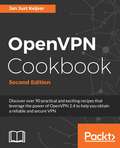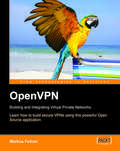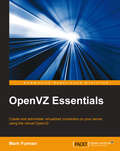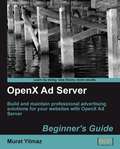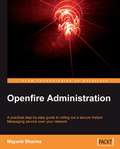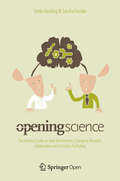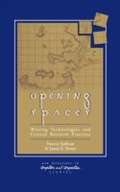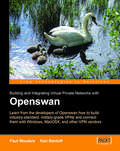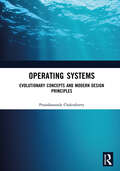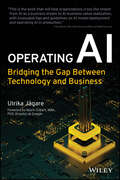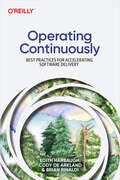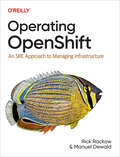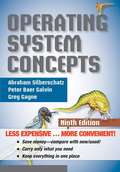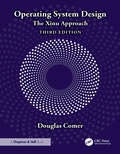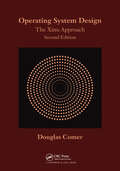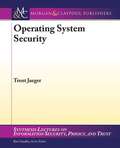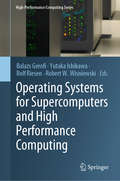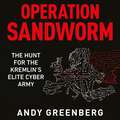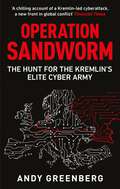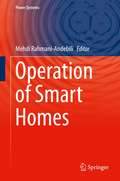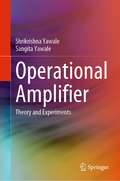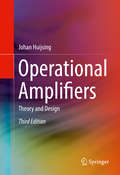- Table View
- List View
OpenVPN Cookbook - Second Edition
by Jan Just KeijserDiscover over 90 practical and exciting recipes that leverage the power of OpenVPN 2.4 to help you obtain a reliable and secure VPN About This Book • Master the skills of configuring, managing, and securing your VPN using the latest OpenVPN • Gain expertise in establishing IPv6 connections and understand PolarSSL using the latest version of OpenVPN • This book contains enticing recipes about OpenVPN functionalities that cater to mission critical applications Who This Book Is For This book is for system administrators who have a basic knowledge of OpenVPN and are eagerly waiting to build, secure, and manage VPNs using the latest version. This book assumes some prior knowledge of TCP/IP networking and OpenVPN and you must have network administration skills to get the most out of this book. What You Will Learn • Determine the best type of OpenVPN setup for your networking needs • Get to grips with the encryption, authentication, and certifications features of OpenSSL. • Integrate an OpenVPN server into the local IT infrastructure with the scripting features of OpenVPN • Ease the integration of Windows clients into the VPN using Windows-specific client-side configuration • Understand the authentication plugins for PAM and LDAP • Get to know the difference between TUN-style and TAP-style networks and when to use what • Troubleshoot your VPN setup • Establish a connection via IPv6 along with demonstrations In Detail OpenVPN provides an extensible VPN framework that has been designed to ease site-specific customization, such as providing the capability to distribute a customized installation package to clients, and supporting alternative authentication methods via OpenVPN's plugin module interface. This book provides you with many different recipes to help you set up, monitor, and troubleshoot an OpenVPN network. You will learn to configure a scalable, load-balanced VPN server farm that can handle thousands of dynamic connections from incoming VPN clients. You will also get to grips with the encryption, authentication, security, extensibility, and certifications features of OpenSSL. You will also get an understanding of IPv6 support and will get a demonstration of how to establish a connection via IPv64. This book will explore all the advanced features of OpenVPN and even some undocumented options, covering all the common network setups such as point-to-point networks and multi-client TUN-style and TAP-style networks. Finally, you will learn to manage, secure, and troubleshoot your virtual private networks using OpenVPN 2.4. Style and approach This practical, recipe-based book covers the core functionalities of OpenVPN ending with troubleshooting, performance tuning and making the readers inquisitive about the advanced features.
OpenVPN: Building and Integrating Virtual Private Networks
by Markus FeilnerNetwork administrators and any one who is interested in building secure VPNs using OpenVPN. It presumes basic knowledge of Linux, but no knowledge of VPNs is required. All basic VPN and relevant security concepts are covered.
OpenVZ Essentials
by Mark FurmanOpenVZ (Open Virtuozzo) is an OS-level virtualization technology based on the Linux kernel and OS written in C. It creates multiple secure and isolated Linux containers on a single physical server, enabling better server utilization and ensuring that applications do not conflict. OpenVZ is the only highly scalable virtualization technology with near-zero overhead, strong isolation, and rapid customer provisioning that's ready for production use right now. Starting with the very basics of OpenVZ, you will learn to configure templates, create containers, administer your server infrastructure, and utilize the OpenVZ Web Panel. Packed with practical examples and precise instructions, this book helps you to set up and configure OpenVZ. An easy-to-follow guide that will help you with real-world container administration tasks. The book has a natural flow from one topic to another and will ensure that you gain expertise in the effective implementation of OpenVZ.
OpenX Ad Server: Beginner's Guide
by Murat YilmazWritten with a step-by-step but friendly and engaging approach, this Packt Beginner's Guide is designed to be placed alongside the computer as your guide and mentor. Step-by-step tutorials are boosted by explanations of the reasoning behind what you are doing. You will quickly pick up the necessary skills, tips, and tricks for building a successful OpenX ad server with practical examples that help you to learn by experiment and play. If you are an enthusiast with clear IT basics, who wants to use OpenX ad server for advertising, then this book is for you.
Openfire Administration
by Mayank SharmaThis book is a functional step-by-step, easy-to-follow reference guide that explains how to use Openfire to develop a secure instant messenger network. Each chapter will tell you how to add features to your IM. Having a simple practical approach, this book is very user-friendly. This book is for System Administrators who want to set up an in-house enterprise IM system using Openfire. The reader will need experience in managing servers on any operating system.
Opening Science
by Sascha Friesike Sönke BartlingModern information and communication technologies, together with a cultural upheaval within the research community, have profoundly changed research in nearly every aspect. Ranging from sharing and discussing ideas in social networks for scientists to new collaborative environments and novel publication formats, knowledge creation and dissemination as we know it is experiencing a vigorous shift towards increased transparency, collaboration and accessibility. Many assume that research workflows will change more in the next 20 years than they have in the last 200. This book provides researchers, decision makers, and other scientific stakeholders with a snapshot of the basics, the tools, and the underlying visions that drive the current scientific (r)evolution, often called 'Open Science. '
Opening Spaces: Writing Technologies and Critical Research Practices
by Patricia Sullivan James E. PorterThis book argues for a "post critical research methodology" and applies this frame to the study of computers and writing: the book opens a space where theoretical scholarship and empirical research can interact.
Openswan: Building and Integrating Virtual Private Networks
by Paul Wouters Ken BantoftNetwork administrators and any one who is interested in building secure VPNs using Openswan. It presumes basic knowledge of Linux, but no knowledge of VPNs is required.
Operating Systems: Evolutionary Concepts and Modern Design Principles
by Pranabananda ChakrabortyThis text demystifies the subject of operating systems by using a simple step-by-step approach, from fundamentals to modern concepts of traditional uniprocessor operating systems, in addition to advanced operating systems on various multiple-processor platforms and also real-time operating systems (RTOSs). While giving insight into the generic operating systems of today, its primary objective is to integrate concepts, techniques, and case studies into cohesive chapters that provide a reasonable balance between theoretical design issues and practical implementation details. It addresses most of the issues that need to be resolved in the design and development of continuously evolving, rich, diversified modern operating systems and describes successful implementation approaches in the form of abstract models and algorithms. This book is primarily intended for use in undergraduate courses in any discipline and also for a substantial portion of postgraduate courses that include the subject of operating systems. It can also be used for self-study. Key Features • Exhaustive discussions on traditional uniprocessor-based generic operating systems with figures, tables, and also real-life implementations of Windows, UNIX, Linux, and to some extent Sun Solaris.• Separate chapter on security and protection: a grand challenge in the domain of today’s operating systems, describing many different issues, including implementation in modern operating systems like UNIX, Linux, and Windows.• Separate chapter on advanced operating systems detailing major design issues and salient features of multiple-processor-based operating systems, including distributed operating systems. Cluster architecture; a low-cost base substitute for true distributed systems is explained including its classification, merits, and drawbacks.• Separate chapter on real-time operating systems containing fundamental topics, useful concepts, and major issues, as well as a few different types of real-life implementations. • Online Support Material is provided to negotiate acute page constraint which is exclusively a part and parcel of the text delivered in this book containing the chapter-wise/topic-wise detail explanation with representative figures of many important areas for the completeness of the narratives.
Operating .NET Framework-based Applications
by Microsoft CorporationGet reliable, real-world answers to your questions about application deployment for Microsoft® .NET. This guide provides practical, prescriptive guidance for administrators monitoring and maintaining enterprise-level business applications based on the.NET Framework within hybrid data center environments. It also provides key information for developers designing and creating these .NET Framework-based applications. Focusing on three critical areas--security, monitoring and reporting, and sizing and capacity planning--the book recommends best solutions within each scenario. All PATTERNS & PRACTICES guides are reviewed and approved by Microsoft engineering teams, consultants, partners, and customers--delivering accurate, real-world information that's been technically validated and tested.
Operating AI: Bridging the Gap Between Technology and Business
by Ulrika JagareA holistic and real-world approach to operationalizing artificial intelligence in your company In Operating AI, Director of Technology and Architecture at Ericsson AB, Ulrika Jägare, delivers an eye-opening new discussion of how to introduce your organization to artificial intelligence by balancing data engineering, model development, and AI operations. You'll learn the importance of embracing an AI operational mindset to successfully operate AI and lead AI initiatives through the entire lifecycle, including key aspects of security, privacy, and data rights. In the book, you’ll also discover: How to reduce the risk of entering bias in our artificial intelligence solutions The importance of efficient and reproduceable data pipelines, including how to manage your company's data An operational perspective on the development of AI models using the MLOps (Machine Learning Operations) approach, including how to deploy, run and monitor models and ML pipelines in production, that generates value in the real world With a strong emphasis on deployment and operations of trustworthy and reliable AI solutions that operate well in the real world—and not just the lab—Operating AI is a must-read for business leaders looking for ways to operationalize an AI business model that actually makes money, from the concept phase to running in a live production environment.
Operating Continuously: Best Practices for Accelerating Software Delivery
by Brian Rinaldi Edith Harbaugh Cody De ArklandSoftware delivery doesn't stop with deployment. Modern teams rely on an emerging set of best practices post-deployment to continuously improve, release, and operate their software. With this practical guide, CTOs, software architects, and senior engineering leaders will learn how to apply these practices to their existing operations. Authors Edith Harbaugh, Cody De Arkland, and Brian Rinaldi provide actionable insights into setting up and maintaining a smooth operational process post-deployment. You'll learn new approaches to releasing software, controlling systems at runtime, and measuring the impact of change. This book helps you: Understand how modern development processes have moved beyond the DevOps infinity loop Understand the evolution of CI/CD, and the operational impacts of that change Use the tools and processes necessary to measure the impact of change on production systems Explore an emerging class of techniques to separate deployment from release Learn how to use canary launches and feature flags to release faster with less risk Use experimentation and impact analysis to drive data driven software improvements
Operating OpenShift: An SRE Approach to Managing Infrastructure
by Rick Rackow Manuel DewaldKubernetes has gained significant popularity over the past few years, with OpenShift as one of its most mature and prominent distributions. But while OpenShift provides several layers of abstraction over vanilla Kubernetes, this software can quickly become overwhelming because of itsrich feature set and functionality. This practical book helps you understand and manage OpenShift clusters from minimal deployment to large multicluster installations.Principal site reliability engineers Rick Rackow and Manuel Dewald, who worked together on Red Hat's managed OpenShift offering for years, provide valuable advice to help your teams operate OpenShift clusters efficiently. Designed for SREs, system administrators, DevOps engineers, andcloud architects, Operating OpenShift encourages consistent and easy container orchestration and helps reduce the effort of deploying a Kubernetes platform. You'll learn why OpenShift has become highly attractive to enterprises large and small.Learn OpenShift core concepts and deployment strategiesExplore multicluster OpenShift Container Platform deploymentsAdminister OpenShift clusters following best practicesLearn best practices for deploying workloads to OpenShiftMonitor OpenShift clusters through state-of-the-art conceptsBuild and deploy Kubernetes operators to automate administrative tasksConfigure OpenShift clusters using a GitOps approach
Operating System Concepts
by Abraham Silberschatz Greg Gagne Peter GalvinThis text is an unbound, binder-ready edition. Operating System Concepts, now in its ninth edition, continues to provide a solid theoretical foundation for understanding operating systems. The ninth edition has been thoroughly updated to include contemporary examples of how operating systems function. The text includes content to bridge the gap between concepts and actual implementations. End-of-chapter problems, exercises, review questions, and programming exercises help to further reinforce important concepts. A new Virtual Machine provides interactive exercises to help engage students with the material.
Operating System Design: The Xinu Approach
by Douglas ComerLauded for avoiding the typical vague, high-level survey approach found in many texts, earlier editions of this bestselling book removed the mystery by explaining the internal structure of an operating system in clear, readable prose. The third edition of Operating System Design: The Xinu Approach expands and extends the text to include new chapters on a pipe mechanism, multicore operating systems, and considerations of operating systems being used in unexpected ways.The text covers all major operating system components, including the key topics of scheduling and context switching, physical and virtual memory management, file systems, device drivers, device-independent I/O, Internet communication, and user interfaces. More important, the book follows a logical architecture that places each component in a multi-level hierarchy. It simplifies learning about operating systems by allowing a reader to understand one level at a time without needing forward references. It starts with a bare machine and builds the system level by level. In the end, a reader will appreciate how all the components of an operating system work together to form a unified, integrated platform that allows arbitrary application programs to run concurrently.The text uses a small, elegant system named Xinu as an example to illustrate the concepts and principles and make the discussion concrete. Because an operating system must deal with the underlying hardware, the text shows examples for the two basic computer architectural approaches used in the computer industry: CISC and RISC. Readers will see that most of the code remains identical across the two architectures, and they can easily compare the differences among the machine-dependent pieces, such as hardware initialization code, device interface code, and context switch code.Xinu code is freely available, and readers are strongly encouraged to download the system and experiment by making modifications or extensions. The Xinu web page, https://xinu.cs.purdue.edu, contains links to the code from the book as well as instructions on how to run Xinu on experimenter hardware boards. The page also provides links to a version that runs on the (free) VirtualBox hypervisor. A reader can install VirtualBox on their laptop or desktop, and then run Xinu without the need for additional hardware.
Operating System Design: The Xinu Approach, Second Edition
by Douglas ComerAvoiding the typical black box approach found in other operating system textbooks, this bestselling book explains how to build an operating system from the ground up. It removes the mystery from operating system design and consolidates the body of material into a systematic discipline. The text presents a hierarchical design paradigm that organizes major operating system components in an orderly, understandable manner. This second edition has been completely rewritten with updated code throughout and examples for two low-cost experimenter boards.
Operating Systems Security (Synthesis Lectures On Information Security, Privacy, And Trust Ser.)
by Trent Jaeger Ravi SandhuOperating systems provide the fundamental mechanisms for securing computer processing. Since the 1960s, operating systems designers have explored how to build "secure" operating systems - operating systems whose mechanisms protect the system against a motivated adversary. Recently, the importance of ensuring such security has become a mainstream issue for all operating systems. In this book, we examine past research that outlines the requirements for a secure operating system and research that implements example systems that aim for such requirements. For system designs that aimed to satisfy these requirements, we see that the complexity of software systems often results in implementation challenges that we are still exploring to this day. However, if a system design does not aim for achieving the secure operating system requirements, then its security features fail to protect the system in a myriad of ways. We also study systems that have been retrofit with secure operating system features after an initial deployment. In all cases, the conflict between function on one hand and security on the other leads to difficult choices and the potential for unwise compromises. From this book, we hope that systems designers and implementors will learn the requirements for operating systems that effectively enforce security and will better understand how to manage the balance between function and security.
Operating Systems for Supercomputers and High Performance Computing (High-Performance Computing Series #1)
by Balazs Gerofi Yutaka Ishikawa Rolf Riesen Robert W. WisniewskiFew works are as timely and critical to the advancement of high performance computing than is this new up-to-date treatise on leading-edge directions of operating systems. It is a first-hand product of many of the leaders in this rapidly evolving field and possibly the most comprehensive. This new and important book masterfully presents the major alternative concepts driving the future of operating system design for high performance computing. In particular, it describes the major advances of monolithic operating systems such as Linux and Unix that dominate the TOP500 list. It also presents the state of the art in lightweight kernels that exhibit high efficiency and scalability at the loss of generality. Finally, this work looks forward to possibly the most promising strategy of a hybrid structure combining full service functionality with lightweight kernel operation. With this, it is likely that this new work will find its way on the shelves of almost everyone who is in any way engaged in the multi-discipline of high performance computing.(From the foreword by Thomas Sterling)
Operation Sandworm: The Hunt for the Kremlin's Elite Cyber Army
by Andy Greenberg*This book is published in the US as Sandworm: A New Era of Cyberwar and the Hunt for the Kremlin's Most Dangerous Hackers. The text is unchanged for this edition, except for the addition of a new foreword.*'With the nuance of a reporter and the pace of a thriller writer, Andy Greenberg gives us a glimpse of the cyberwars of the future while at the same time placing his story in the long arc of Russian and Ukrainian history.' -Anne Applebaum, bestselling author of Twilight of Democracy'A chilling account of a Kremlin-led cyberattack, a new front in global conflict" -Financial TimesThe true story of the most devastating act of cyberwarfare in history and the desperate hunt to identify and track the elite Russian agents behind it.In 2014, the world witnessed the start of a mysterious series of cyberattacks. Targeting American utility companies, NATO, and electric grids in Eastern Europe, the strikes grew ever more brazen. They culminated in the summer of 2017, when the malware known as NotPetya was unleashed, penetrating, disrupting, and paralyzing some of the world's largest businesses. At the attack's epicenter in Ukraine, ATMs froze. The railway and postal systems shut down. Hospitals went dark. NotPetya spread around the world, inflicting an unprecedented ten billion dollars in damage - the largest, most destructive cyberattack the world had ever seen.This is the true story of the hunt to unmask Sandworm: the group of hackers behind the attacks working in service of Russia's military intelligence agency. Following the years-long, globe-spanning work of the detectives tracking them, Operation Sandworm also exposes the larger story of a new global arms race, and the geopolitical chaos it is unleashing on the world. A narrative full of twists and turns, it captures a chilling new reality: in a war without borders, all of us live on the frontline.
Operation Sandworm: The Hunt for the Kremlin's Elite Cyber Army
by Andy Greenberg*This book is published in the US as Sandworm: A New Era of Cyberwar and the Hunt for the Kremlin's Most Dangerous Hackers. The text is unchanged for this edition, except for the addition of a new foreword.*'With the nuance of a reporter and the pace of a thriller writer, Andy Greenberg gives us a glimpse of the cyberwars of the future while at the same time placing his story in the long arc of Russian and Ukrainian history.' -Anne Applebaum, bestselling author of Twilight of Democracy'A chilling account of a Kremlin-led cyberattack, a new front in global conflict" -Financial TimesThe true story of the most devastating act of cyberwarfare in history and the desperate hunt to identify and track the elite Russian agents behind it.In 2014, the world witnessed the start of a mysterious series of cyberattacks. Targeting American utility companies, NATO, and electric grids in Eastern Europe, the strikes grew ever more brazen. They culminated in the summer of 2017, when the malware known as NotPetya was unleashed, penetrating, disrupting, and paralyzing some of the world's largest businesses. At the attack's epicenter in Ukraine, ATMs froze. The railway and postal systems shut down. Hospitals went dark. NotPetya spread around the world, inflicting an unprecedented ten billion dollars in damage - the largest, most destructive cyberattack the world had ever seen.This is the true story of the hunt to unmask Sandworm: the group of hackers behind the attacks working in service of Russia's military intelligence agency. Following the years-long, globe-spanning work of the detectives tracking them, Operation Sandworm also exposes the larger story of a new global arms race, and the geopolitical chaos it is unleashing on the world. A narrative full of twists and turns, it captures a chilling new reality: in a war without borders, all of us live on the frontline.
Operation of Smart Homes (Power Systems)
by Mehdi Rahmani-AndebiliThis book presents the latest research advancements in the operation of smart homes. It comprises new operation techniques including cooperative distributed energy scheduling, framework to react to malicious cyberattacks, framework for demand-side management, and framework for the design of smart homes to support residents’ wellness as well as new optimization techniques such as stochastic model predictive control and multi-time scale optimization. In addition, the book analyzes 11,000 studies that have been indexed in scientific databases and categorizes them based on various data points, including the field and the subject of the research, the name of the institutions, and the nationality of the authors.Presents new operation techniques of smart homes;Introduces new optimization techniques for operation of smart homes;Analyses 11,000 studies and categorizes them based on different data points.
Operational Amplifier: Theory and Experiments
by Shrikrishna Yawale Sangita YawaleThis book covers several aspects of the operational amplifier and includes theoretical explanations with simplified expressions and derivations. The book is designed to serve as a textbook for courses offered to undergraduate and postgraduate students enrolled in electronics and communication engineering. The topics included are DC amplifier, AC/DC analysis of DC amplifier, relevant derivations, a block diagram of the operational amplifier, positive and negative feedbacks, amplitude modulator, current to voltage and voltage to current converters, DAC and ADC, integrator, differentiator, active filters, comparators, sinusoidal and non-sinusoidal waveform generators, phase lock loop (PLL), etc. This book contains two parts—sections A and B. Section A includes theory, methodology, circuit design and derivations. Section B explains the design and study of experiments for laboratory practice. Laboratory experiments enable students to perform a practical activity that demonstrates applications of the operational amplifier. A simplified description of the circuits, working principle and practical approach towards understanding the concept is a unique feature of this book. Simple methods and easy steps of the derivation and lucid presentation are some other traits of this book for readers that do not have any background information about electronics. This book is student-centric towards the basics of the operational amplifier and its applications. The detailed coverage and pedagogical tools make this an ideal textbook for students and researchers enrolled in senior undergraduate and beginning postgraduate electronics and communication engineering courses.
Operational Amplifiers
by Johan HuijsingOperational Amplifiers - Theory and Design, Second Edition presents a systematic circuit design of operational amplifiers. Containing state-of-the-art material as well as the essentials, the book is written to appeal to both the circuit designer and the system designer. It is shown that the topology of all operational amplifiers can be divided into nine main overall configurations. These configurations range from one gain stage up to four or more stages. Many famous designs are evaluated in depth. Additional chapters included are on systematic design of µV-offset operational amplifiers and precision instrumentation amplifiers by applying chopping, auto-zeroing, and dynamic element-matching techniques. Also, techniques for frequency compensation of amplifiers with high capacitive loads have been added. Operational Amplifiers - Theory and Design, Second Edition presents high-frequency compensation techniques to HF-stabilize all nine configurations. Special emphasis is placed on low-power low-voltage architectures with rail-to-rail input and output ranges. In addition to presenting characterization of operational amplifiers by macro models and error matrices, together with measurement techniques for their parameters it also develops the design of fully differential operational amplifiers and operational floating amplifiers. Operational Amplifiers - Theory and Design, Second Edition is carefully structured and enriched by numerous figures, problems and simulation exercises and is ideal for the purpose of self-study and self-evaluation.
Operational Auditing: Principles and Techniques for a Changing World (Internal Audit and IT Audit #11)
by Hernan MurdockInternal auditors are expected to perform risk-based audits, but do so partially because they focus on financial and compliance risks at the expense of operational, strategic and technological ones. This limits their ability to evaluate critical risks and processes. This book merges traditional internal audit concepts and practices with contemporary quality control methodologies, tips, tools and techniques. It helps internal auditors perform value-added operational audits that result in meaningful findings and useful recommendations to help organizations meet objectives and improve the perception of internal auditors as high-value contributors, appropriate change agents and trusted advisors.
Operational Auditing: Principles and Techniques for a Changing World (Internal Audit and IT Audit #11)
by Hernan MurdockOperational Auditing: Principles and Techniques for a Changing World, 2nd edition, explains the proven approaches and essential procedures to perform risk-based operational audits. It shows how to effectively evaluate the relevant dynamics associated with programs and processes, including operational, strategic, technological, financial and compliance objectives and risks. This book merges traditional internal audit concepts and practices with contemporary quality control methodologies, tips, tools and techniques. It explains how internal auditors can perform operational audits that result in meaningful findings and useful recommendations to help organizations meet objectives and improve the perception of internal auditors as high-value contributors, appropriate change agents and trusted advisors. The 2nd edition introduces or expands the previous coverage of: • Control self-assessments. • The 7 Es framework for operational quality. • Linkages to ISO 9000. • Flowcharting techniques and value-stream analysis • Continuous monitoring. • The use of Key Performance Indicators (KPIs) and Key Risk Indicators (KRIs). • Robotic process automation (RPA), artificial intelligence (AI) and machine learning (ML); and • Adds a new chapter that will examine the role of organizational structure and its impact on effective communications, task allocation, coordination, and operational resiliency to more effectively respond to market demands.
